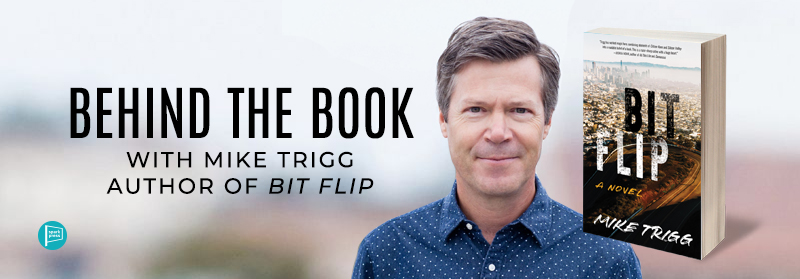
I describe my debut novel, Bit Flip, as a “corporate thriller.” Although that term may sound like an oxymoron to some, I believe our professional lives are rich with drama and intrigue that make for highly resonant stories. After all, most of us spend over a third of our lives at work, yet novels set in a professional environment are under-represented in literature.
Prior to writing my first novel, I spent over 20 years in the technology industry, mostly as a founder or early employee at Silicon Valley tech startups. Over that time, I saw just about everything—from euphoric success to soul-crushing defeat. The inherent pressures of an early-stage company that can be snuffed out of existence at almost any moment bring out the entire range of human emotion. In this environment, one sees both the best in people, and the worst. In other words, perfect fodder for story telling!
I was inspired to write a story set within a tech start-up because much of what I read about the tech industry struck me as inauthentic. The stories about Silicon Valley, whether fiction or nonfiction, tended to either glorify or vilify the people and culture of this industry. I wanted to write a novel that was believable to insiders, and I felt that, by doing so, it would also be interesting and credible for any reader—just like a spy novel is more credible if it is written by a former CIA agent, or a police procedural is more credible if it is written by a former detective. So I tapped into my extensive professional experience in the tech world as my source of literary inspiration.
Particularly for a first novel, the advice to “write what you know” was very helpful for me. However, the reality for me—and for most novelists looking to weave their professional experience into a novel—is my workplaces were not the CIA. The pitfall of writing a novel about work is it can feel like . . . a story about work. And who wants to read that?
So, if you’re aspiring to write a novel derived from your professional experience, I offer these tips to keep your story engaging and your readers reading.
Tell a story, not a series of anecdotes—The original material for my book started as a bunch of anecdotes. Basically, just funny, heart-warming, or eye-rolling vignettes that I witnessed in my day-to-day life as a technology professional. Although such details can bring color and depth to a story, a series of unrelated anecdotes is boring to read. You need to start with a solid story arc, then find space for only the best anecdotes that propel your story forward. Think of these professional anecdotes as seasoning on top of the main dish of your story.
Be an insider, but not too much—Readers want a view into your professional world. They want a taste of what it’s like to work in that profession. The authenticity is in the details. But don’t get into the weeds or you’ll lose people. Add just enough of the lingo, cultural norms, and organizational practices to make the story believable, but don’t bludgeon readers with details that are irrelevant to the plot. In my first draft of Bit Flip, I wrote way too much inside baseball from my experiences at tech start-ups. Cutting most of that detail out improved the story dramatically.
Supersize the action—Workplace drama can seem life-or-death when you’re in the middle of it yourself, but those same experiences can feel mundane when you’re a reader watching from the sidelines. Don’t be afraid to punch up the behaviors, eccentricities, and poor decision-making a few notches. When you’re right up to the edge of feeling like “this would never happen,” that’s probably the level that your audience will find compelling.
Create composite characters—If you simply want to roast your co-workers, write a tell-all memoir. (Caveat: only write said memoir in the unlikely event any reader would know or care about the co-workers you’re roasting.) Instead, assuming you’re writing a work of fiction, borrow, derive, and appropriate the most interesting personality traits from a wide range of people and embody those in your characters. That’s what will make your characters feel authentic despite being fictionalized.
Focus on the human condition—Remember a professional workplace is just a setting, it’s not the whole story. Even in the most dramatic professional environments—police departments, hospitals, courtrooms, etc.—the organization itself is only there to serve as a framework for your characters’ behavior. Companies are inanimate objects without emotions, uncertainties, or ambitions. The real story is always about the human interest. Focus on how the characters in your workplace setting evolve and change.
In my book, Bit Flip, I applied these tips to elevate the narrative above a story merely about a tech start-up. With these techniques, it evolved into a cautionary tale about the downfalls of unbridled ambition and a critique of contemporary tech culture. For further inspiration, some excellent recent examples of novels set in professional environments that hit these higher literary notes include, All Her Little Secrets by Wanda Morris, The Every by Dave Eggers, and Then We Came to the End by Joshua Ferris. I hope these tips help you derive literary inspiration from your career experiences to deliver a compelling novel.
Mike Trigg is an author and former tech executive. Follow Mike on Facebook, Twitter, and Goodreads, or on miketrigg.com.

Leave A Comment